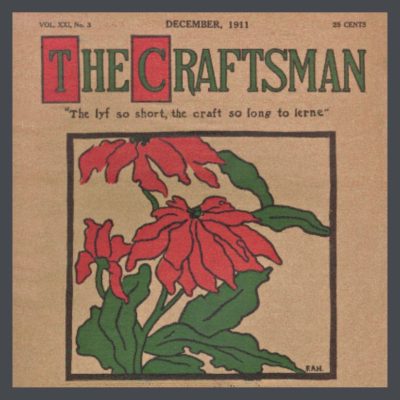 CHRISTMAS DECORATIONS FROM WINTER’S GARDEN
CHRISTMAS DECORATIONS FROM WINTER’S GARDEN
December, 1911
In tracing the custom of decorating the church and home with green boughs, vines and flowers on Christmas day—a custom dear to many people in many lands—we wander through both Christian and pagan eras. The records disclose curious, interesting and beautiful facts and fancies of historical and poetical importance. Some writers see in this custom a yearly commemoration of Christ’s entry into Jerusalem when the people waved pine branches as token of their rejoicing.
In Isaiah we read, “The glory of Lebanon shall come unto thee, the fir-tree, the pine-tree and the box together to beautify the place of my sanctuary.” Nehemiah commanded the people, on some occasion of rejoicing, to “go forth unto the mount and fetch olive branches and myrtle branches and palm branches and branches of thick trees.”
It seems strange that in spite of these authoritative quotations and incidents, the early Christians forbade the use of flowers and branches in their church, no matter what the occasion. The Puritans also denounced the use of flowers or greens as “vain abominations” for the same reason—namely, that the custom was said to be of pagan origin. “Trymming of the temples with hangynges, flowers, boughs and garlondes was taken from the heathen people, whiche decked their idols and houses with suche array,” wrote Polydore Vergil.
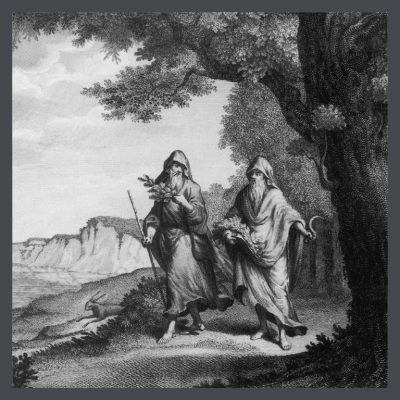 The reason among the Druids for bringing in bits of evergreen from the woods and adorning the house is a most charming and lovable one—”The houses were decked with evergreens in December that the sylvan spirits might repair to them and remain unnipped with frost and cold winds until a milder season had renewed the foliage of their darling abodes.” How gracious a way of luring the shy, sweet wild-woods spirits into the homes of men!
The reason among the Druids for bringing in bits of evergreen from the woods and adorning the house is a most charming and lovable one—”The houses were decked with evergreens in December that the sylvan spirits might repair to them and remain unnipped with frost and cold winds until a milder season had renewed the foliage of their darling abodes.” How gracious a way of luring the shy, sweet wild-woods spirits into the homes of men!
The Druids with ceremonies of great solemnity used to collect mistletoe “against the festival of winter solstice.” Only the oaks bearing mistletoe were sacred to this ancient order of men, and they made solemn processions to such oaks, a prince of the order cutting the mistletoe with a golden sickle. It is recorded that the people’s reverence for the priests proceeded in great measure from the cures which the priests effected by means of this curious green plant of the pearl-like berries. It was collected thus ceremoniously by the Druids because it was supposed to drive away evil spirits.
Sir John Colbatch boldly said that “it must have been designed by the Almighty for further and more noble purpose than barely to feed thrushes or to be hung up surreptitiously to drive away evil spirits.”
 But whatever the origin of decking our homes with holly, mistletoe or with branches of any green plant hardy enough to carry with it a hint of immortality by remaining fresh and green throughout the apparent death of the world during the winter—the custom is now well established, and who would willingly let it slip into oblivion! It would seem strange indeed not to welcome this child’s festival,—the holiest festival of the year’s calendar,—with fragrant boughs from the forest set at our doorways and windows and on our altars. It is a fitting and beautiful way to symbolize our love and worship of the One who made immortality credible.
But whatever the origin of decking our homes with holly, mistletoe or with branches of any green plant hardy enough to carry with it a hint of immortality by remaining fresh and green throughout the apparent death of the world during the winter—the custom is now well established, and who would willingly let it slip into oblivion! It would seem strange indeed not to welcome this child’s festival,—the holiest festival of the year’s calendar,—with fragrant boughs from the forest set at our doorways and windows and on our altars. It is a fitting and beautiful way to symbolize our love and worship of the One who made immortality credible.
Nature has set many a lovely plant in her winter garden of rich perpetual green, giving some of them an added charm of scarlet berry, or berry of blue or white or purple. Some have hardy, glossy leaves of wonderful shapeliness, some of them have fragrant needles, some exhale rare aromatic incense, some even put forth hardy flowers of glowing crimson or purest white.
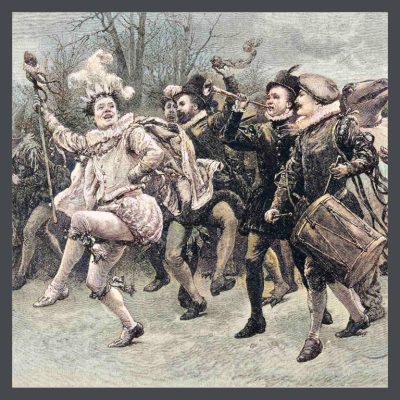 Of those bearing bright berries that we can gather from the woods or fields to adorn our homes at this Christmas season, perhaps the general favorite in the East is the holly—in the West it is the toyon. These two glossy leaved bushes of the scarlet berries are too well known to need words in their favor. The mistletoe of the South and of the West should be mentioned in the same breath with these favorites, for they are closely associated in our minds. The “Lord of Misrule” and the “Abbot of Unreason” [both terms apply to a peasant or low level church official appointed to be in charge of Christmas revelries, which often included drunkenness and wild partying] have claimed these white Christmas berries from the time of their first hilarious coronation day when fate was precipitated with surety upon the head of the maiden of their merry courts who was caught under the fruiting branch of their wand—the mistletoe bough!
Of those bearing bright berries that we can gather from the woods or fields to adorn our homes at this Christmas season, perhaps the general favorite in the East is the holly—in the West it is the toyon. These two glossy leaved bushes of the scarlet berries are too well known to need words in their favor. The mistletoe of the South and of the West should be mentioned in the same breath with these favorites, for they are closely associated in our minds. The “Lord of Misrule” and the “Abbot of Unreason” [both terms apply to a peasant or low level church official appointed to be in charge of Christmas revelries, which often included drunkenness and wild partying] have claimed these white Christmas berries from the time of their first hilarious coronation day when fate was precipitated with surety upon the head of the maiden of their merry courts who was caught under the fruiting branch of their wand—the mistletoe bough!
The snowberry that holds large waxy berries through most of the winter is well known in both the East and the West and lightens dark corners of rooms in most decorative way, looking like miniature snowballs—that do not fade away at the approach of fire. Barberries have won a well-deserved popularity as Christmas decorations, so also has the winterberry or black alder with its red fruit. Several of our thorn bushes show bright berries in the whiter. The viburnums with black berries, the wild currant with small but pretty red fruit, the spindle tree with pink berries and the orange and red bittersweet can be obtained with a little search of open groves and sheltered pastures.
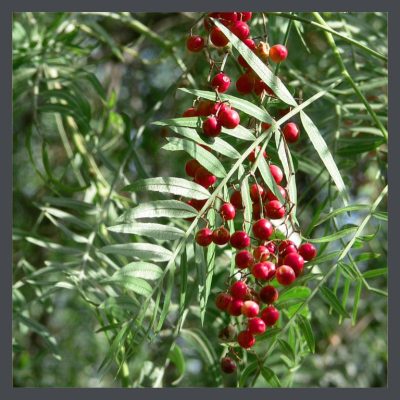 Among the evergreens whose beautiful leaves are polished to glossiest perfection by Jack Frost, are the magnolias, rhododendrons, mountain laurel, bay laurel, madrone. The pepper tree of the Southwest drips with red berries as well as sparkles with shining leaves. The checkerberry also combines red berries and polished leaves, though it is a tiny humble little plant compared to the showy pepper tree. Galax leaves are coming into favor, and deservedly so, for they are of the richest, glossiest dark green and bronze, and their heart-shaped surfaces are beautifully veined, a fine example of natural engraving.
Among the evergreens whose beautiful leaves are polished to glossiest perfection by Jack Frost, are the magnolias, rhododendrons, mountain laurel, bay laurel, madrone. The pepper tree of the Southwest drips with red berries as well as sparkles with shining leaves. The checkerberry also combines red berries and polished leaves, though it is a tiny humble little plant compared to the showy pepper tree. Galax leaves are coming into favor, and deservedly so, for they are of the richest, glossiest dark green and bronze, and their heart-shaped surfaces are beautifully veined, a fine example of natural engraving.
As to vines with which to drape mantel, table and picture, the wild smilax of the South and the ground pine of the North cannot be surpassed, for they are charmingly graceful, retain their fresh color for a long time and have decorative qualities wherever placed. The Christmas fern which grows quite universally throughout the country is another graceful plant that lends itself graciously to decorations of every nature. The winter garden shoves nothing lovelier than the shapely green fronds of this fern, and it retains its rich green whether covered with snow or taken into the warm atmosphere of the home.
 Besides all these green things that are to be had as reward of a walk in field or forest, are the evergreen trees of all kinds, the firs, spruces, arborvitaes, pines, hemlocks, whose balsamic fragrance add so much to Christmas cheer. The Christmas rose should be better known—should be made to bloom in our gardens as well as in Nature’s garden.
Besides all these green things that are to be had as reward of a walk in field or forest, are the evergreen trees of all kinds, the firs, spruces, arborvitaes, pines, hemlocks, whose balsamic fragrance add so much to Christmas cheer. The Christmas rose should be better known—should be made to bloom in our gardens as well as in Nature’s garden.
Delicate mosses, lichens and little rock ferns can often be found on the sheltered side of rocks, that are as green as when summer holds sway over our land.
With such an array of green growing things to choose from, things full of sentiment, of dear associations, of rare beauty, why not give ourselves the joy of a search for them through winter fields and woods ? Would not such a search be just about the best part of the season’s merry making. ”Would we not be entering more into the spirit of Christmas by going out to meet it, as it were, by searching for these aromatic symbols of immortality and bringing them into our homes, rather than by unromantically ordering wreaths, vines and branches from the florist’s.”
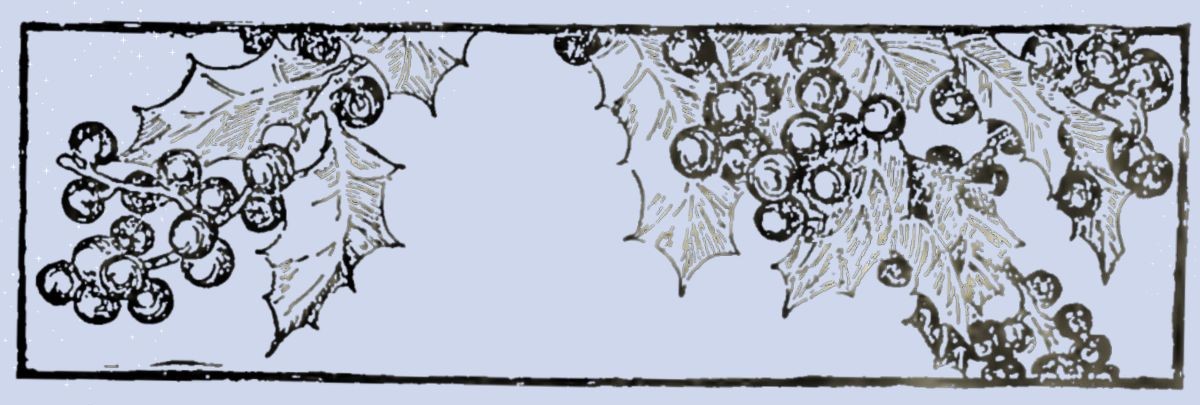
The Craftsman Magazine was the premier publication of the American Arts & Crafts Movement. Each article promotes a natural, simple lifestyle in beautifully expressive prose. Read my article on how I created my Craftsman Magazine Christmas here.
STAY IN THE BUNGALOW KNOW!!!
Sign up for our newsletter & receive our FREE E-book, 7 VITAL Things to Do Before You Hire a Contractor.




0 Comments